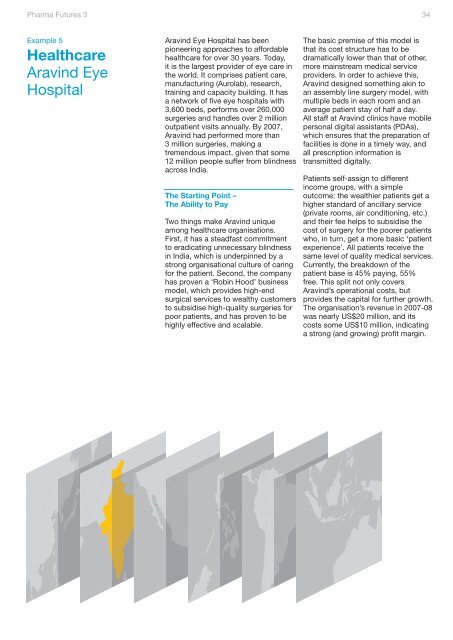Pharma Futures 3 Emerging Opportunities
Pharma Futures 3 Emerging Opportunities
Pharma Futures 3 Emerging Opportunities
Create successful ePaper yourself
Turn your PDF publications into a flip-book with our unique Google optimized e-Paper software.
<strong>Pharma</strong> <strong>Futures</strong> 3<br />
Example 5<br />
Healthcare<br />
Aravind Eye<br />
Hospital<br />
Aravind Eye Hospital has been<br />
pioneering approaches to affordable<br />
healthcare for over 30 years. Today,<br />
it is the largest provider of eye care in<br />
the world. It comprises patient care,<br />
manufacturing (Aurolab), research,<br />
training and capacity building. It has<br />
a network of five eye hospitals with<br />
3,600 beds, performs over 260,000<br />
surgeries and handles over 2 million<br />
outpatient visits annually. By 2007,<br />
Aravind had performed more than<br />
3 million surgeries, making a<br />
tremendous impact, given that some<br />
12 million people suffer from blindness<br />
across India.<br />
The Starting Point –<br />
The Ability to Pay<br />
Two things make Aravind unique<br />
among healthcare organisations.<br />
First, it has a steadfast commitment<br />
to eradicating unnecessary blindness<br />
in India, which is underpinned by a<br />
strong organisational culture of caring<br />
for the patient. Second, the company<br />
has proven a ‘Robin Hood’ business<br />
model, which provides high-end<br />
surgical services to wealthy customers<br />
to subsidise high-quality surgeries for<br />
poor patients, and has proven to be<br />
highly effective and scalable.<br />
34<br />
The basic premise of this model is<br />
that its cost structure has to be<br />
dramatically lower than that of other,<br />
more mainstream medical service<br />
providers. In order to achieve this,<br />
Aravind designed something akin to<br />
an assembly line surgery model, with<br />
multiple beds in each room and an<br />
average patient stay of half a day.<br />
All staff at Aravind clinics have mobile<br />
personal digital assistants (PDAs),<br />
which ensures that the preparation of<br />
facilities is done in a timely way, and<br />
all prescription information is<br />
transmitted digitally.<br />
Patients self-assign to different<br />
income groups, with a simple<br />
outcome: the wealthier patients get a<br />
higher standard of ancillary service<br />
(private rooms, air conditioning, etc.)<br />
and their fee helps to subsidise the<br />
cost of surgery for the poorer patients<br />
who, in turn, get a more basic ‘patient<br />
experience’. All patients receive the<br />
same level of quality medical services.<br />
Currently, the breakdown of the<br />
patient base is 45% paying, 55%<br />
free. This split not only covers<br />
Aravind’s operational costs, but<br />
provides the capital for further growth.<br />
The organisation’s revenue in 2007-08<br />
was nearly US$20 million, and its<br />
costs some US$10 million, indicating<br />
a strong (and growing) profit margin.



